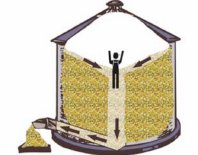Grain Bin Entrapment
The United States-and the world-relies on agriculture to provide food and products to sustain life. Agriculture is one of the most dangerous labor industries to work in. Farmers and ranchers are at an elevated risk for accidents, injuries and even death. This industry is one of the largest in the world, providing around 19.7 million jobs (USDA ERS - Ag and Food Sectors and the Economy), and every branch comes with its dangers.
The top most common accidents in the agriculture industry are:
Overturning tractors and heavy machinery
Falls
Toxic chemical exposure to pesticides
Suffocation
Heat stress
Animal-related injuries
A less-common, but potentially fatal farm accident is grain bin entrapment. Grain bin entrapment can happen in a matter of seconds. Individuals working in the grain industry must know how these incidents happen and be prepared to prevent or respond to the situation. Keeping grain in good condition plays a significant role in preventing these catastrophic incidents. Grain bin entrapment can happen three ways:
1. Entrapment in Flowing Grain
During unloading, the grain in a bin flows downward from the top center of the bin, creating a “funnel” effect that draws material and objects down to the conveyor at the bottom of the bin. The auger at the bottom of the bin moves the grain outside. It can take as little as 2-3 seconds to become trapped in flowing grain. Flowing grain acts like quick sand, pulling people under and causing suffocation.
Prevention
Warn family, employees and visitors of dangers in flowing grain.
Place warning decals on all bin entrances and gravity wagons.
Turn off and lock out power controls to unloading conveyors before entering a bin, using “lock out/tag out” procedures.
Always use a safety harness, safety line and at least two observers during bin entry.
Tie a permanent lifeline in the bin for a person trapped in grain flow to grab (i.e., a rope hanging down from the center with knots tied every few feet).
Secure grain storage areas to prevent unauthorized entry.
2. Collapse of a Grain Bridge
A grain bridge can form when grain on the surface is moldy or stuck together to form a hard, thick crust. When grain is unloaded from a bin with a surface crust, a hollow cavity forms underneath the grain bridge. If an individual enters the bin and attempts to walk on the crusted surface, the additional weight will cause the crust to collapse and the individual could be partially or completely submerged instantly. Shifting grain can move the victim from the point of entry, making it difficult to determine where the victim is located under the grain.
Prevention
To detect whether a grain bridge exists, always look for an inverted cone after unloading grain from a bin. The newly exposed grain surface should look shiny. If it does not, a bridge may have formed.
Use a pole or other object to free the bridge. Do this from the bin roof hatch or from the inside ladder while tied to the ladder securely. Do not stand on the grain surface.
Carry a long pole when entering bins to probe grain for cavities and stabilize the worker in case of grain flow.
Manage grain to avoid conditions that cause spoilage and bridging.
3. Collapse of a Vertical Wall of Grain
Spoiled or poor quality grain can stick against the bin wall in large vertical columns. Workers may try to dislodge the grain by moving it with a stick or shovel. This can cause the grain wall to break free, resulting in an avalanche that can completely bury workers inside the bin. Vibration from trucks outside the bin, running machinery or passing trains can cause the grain wall to release as well.
Prevention
Use a body harness and safety rope that is securely tied off.
Work from top to bottom of a vertical grain wall, staying above the highest part of the wall.
Be prepared for the entire grain wall to break free and fall at any time.
Manage grain to avoid conditions that cause spoilage and formation of vertical grain walls.
More Resources
“SILO” is the product of an extensive collaboration between city-based filmmakers and the rural American community. The entire creative team spent years working with farmers, fire/rescue workers, and trusted agricultural institutions to ensure the authentic portrayal of the all-too-common danger of grain entrapment. “SILO” is not just a dramatic reminder of the importance of agricultural safety — it is also a testament to what communities can accomplish when they work together.
Tolley Fire Department Educational PowerPoint
Thank you to the Tolley Fire Department for bringing attention to this danger.



